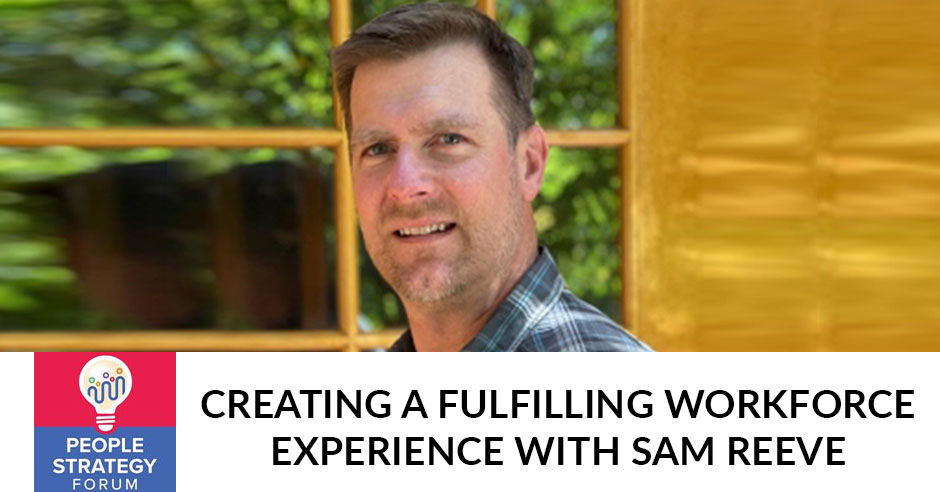Creating A Fulfilling Workforce Experience With Sam Reeve

Getting paid competitively is not enough for many people nowadays. Most of them are looking for a workforce experience that will give them fulfillment. Sam Reeve leads the conversation about how leaders can create a workplace culture that attracts the best people, retains top performers, and motivates every single person within the team. They talk about building trust in leadership, the importance of one-on-one employee conversation, and the power of collaborative teamwork. They also touch on the best approach to accommodating individuals at different stages in their lives, how to provide employee benefits equally, and why you must align with everyone’s personal values.
—
Creating A Fulfilling Workforce Experience With Sam Reeve
We’re excited to have you here, whether it’s your 1st time or 200th time showing up. What an athlete you are showing up consistently. We hope you’re getting a lot of value out of these sessions. We try to bring you as much value in each and every episode. The mission is to energize and elevate your company and your employees. Every episode, we have different guest speakers, but we’re going to change things up a little. We have Sam and Sumit speaking to us about creating work people love. It’s all about the workforce experience. You’ll read The Workforce Experience mentioned a little later because I heard along the grapevine it might be coming out as a book title. I’ll let them share a bit more about that.
Let me introduce you to everybody else that’s here. We’ll start off with Char. She is a former HR professional turned entrepreneur. She’s a career coach, experienced in talent management as well as HR, and is working on her next brand new big business venture down in Mexico, which is going to assist seniors. It’s a very awesome mission. It’s going to help a lot of seniors and the elderly. I am very excited for her there.
We also have Howard who works with the team at CompTeam. He has had a very long career working in the corporate world and knows a lot when it comes to compensation. He’s a real compensation pro. He is experienced in systems and strategies and helps companies update all their software and move to more high-tech software so that they can have better compensation management.
We also have Sumit. He is a people strategist. He has helped many companies transform their human resources areas. He’s helped with strategy, talent management, mergers, and diversity and inclusion initiatives so much. Lastly, we have Sam, who is the Founder and CEO of CompTeam. CompTeam is a company that’s been around for a couple of years now. He knows everything when it comes to pay and talent performance and management. He is a compensation expert. I’m very excited to dive into this topic because there’s a book that’s coming out, but I want to pass it over to Sam and Sumit so that we can find out more about that.
Thank you. It’s a big mystery. We’ve been talking about it. Over the years, Sumit and I have been working on putting together a lot of different talent messages about how to create the overall workforce experience that attracts the best people out there, retains your top performers, and motivates your company overall, all your people that you have.
I’m excited to announce that we’ll be releasing The Workforce Experience as a book and also a series of workshops that go with that and how to create an exceptional workforce experience. We’re going to talk a little bit about that in detail. There are about twelve different areas here to dive into. We’re going to go through this in a little bit of detail. As we start out, I know that part of the reason why we thought that this book was important to write is as a compensation professional, I’ve noticed that getting paid in a competitive range is not enough for companies.
They need to have a whole ecosystem that supports reasons why we should be there as employees, leaders, and so forth. Anything that you do as far as compensation is going to be a Band-Aid, a short-term fix on your issue unless you have the rest of the workforce experience dialed in. I know that I’ve been talking with Char and Howard about this concept for years. Char, you’ve been able to use a lot of these concepts in alignment with the TMA Method in your businesses.
I appreciated CompTeam support and evaluation of our compensation practices to assure that we are in alignment from a compliance standpoint because the industry that my company was in was very much about making sure that you’re compliant. Integrating the talent management TMA concept into that was a very highly effective approach with a full talent management strategy with career architecture in alignment with it. Ultimately, we were becoming a multimillion-dollar company as a result with less than 30 employees. We were like a mini-test, a test pilot. It worked. I’m proud to say thank you Sam for CompTeam for all your support. That was a great process.
Sumit, tell me a little bit about your perspective on the workforce experience and why it’s important.
The reason why it’s important is because we keep hearing about culture becoming such a buzzword. There are talks about renaming HR to people and culture to underscore the importance of culture. Culture isn’t a process. Culture is a destination. You can’t build culture. What you can do is you can create a workforce experience. You can have all those components lining up in order to build a great culture, but sadly, that’s not what gets spoken of in most conversations. We are only talking about building or creating a culture without realizing what are the pillars that contribute to the culture, what are their own components, and what exactly we need to do to get there.
Let me talk a little bit about some of the main pieces that we’re going to be focusing on and walk through these in detail. The first is when we’re looking at all the factors of bringing people together, we’ve identified three as being important. One is how we motivate people. This could be motivating people to join your organization. It could be to have them perform and contribute to your company and so forth.
There are a lot of elements around motivation there. The next is engagement and how we ensure that people have everything they need to do their best work and how we keep them on top of their game as part of the organization. Those reward elements, how do we recognize and ensure that pay is appropriate? How do we create all that important culture that’s going to create a compelling workplace? We’re going to talk about all those elements.
The first thing here to think about is we’re looking at vision as a top piece. What I like to explain here when we’re talking about vision is it’s important to ensure that our leaders come out and set up a very clear story about what the company stands for and where they’re heading or going with that organization. This is the mission and vision overall. The reason why this is important is because people nowadays in our modern workforce want to do more than just earn a paycheck. They want to be part of an organization that stands for something that has a clear path forward. It’s important to make sure that this is well crafted. What do you think about that, Sumit?
The modern workforce wants to do more than just earn a paycheck. They want to be part of an organization that stands for something that has a clear path forward. Share on XI’m fond of examples from sports. Sports people at the highest level are among the best-paid professionals. Have you ever seen them happy to take their paycheck and go back home, or you see them talking about, “I’m moving from this club to that one because I want to win trophies. I want to go to a place that has a plan.” I think that’s exactly what vision is all about.
It’s making sure that there’s that story in place. There are a lot of things that happen. The first thing we see is that there’s a need in the marketplace where that company is trying to fill a specific need. The next is ensuring that they have the plan to fulfill that. Here’s one of the stories I like to talk about because I love history, but when we think about this in the past as far as people migrating to the new world, if you look back in history, there was a time when we discovered this, the Americas, and there was a drive to go over there and explore them and see what this new opportunity is. There were a lot of things that happened nowadays such as the onset of AI or machine learning.
There’s this new opportunity that gets people excited. There needs to be a vision that’s put in place of what that opportunity delivers is this new sense of freedom, for instance, America has a plan for the future where you can be your own person and boss and not be overly regulated. That was very compelling during that time.
The next thing required is leadership. Let me tell you why. If you’re a person that is taking on a boat to go to the new world, especially back in those days when it wasn’t as easy as hopping on a jet to fly from one continent to another, you were going to be faced with a long boat journey on a ship. If you go down to the port and see a bunch of ships down there, they all look the same, but they’re all going to take you to this new world. Which one do you select?
That’s where leadership comes in. If I were in that position where I wanted to jump on a boat and take a couple of weeks’ journey over to the Americas, I would want to ensure that that boat is sound. It’s going to stay afloat during rough seas. There is going to be a captain that can guide or pilot that boat effectively through those rough seas and keep everyone together as a crew at the same time and not have a mutiny on the way.
Ensuring that we have trust in leadership is quite important. I don’t think that we think of that often in our daily lives and how important that is. Our candidates out there are looking for that trusted leader. They want to work for a company that is responsible and has had leadership in the past. They want to be a part of that. What do you think Howard?
What I was thinking before is it’s important to capture both the head and heart of the employees. You want to get the vision out, have it filtered through the organization, and have people buying in. It’s not just and done kind of thing. It has to be permeated throughout the organization and constant in the organization. Many companies spend time creating a vision and posting it on the wall and creating nice brochures and then that’s it. If you don’t have the leadership buying into it and filtering it down to the employees and employees also understanding and buying in, you’ve lost it.
Leaders are not only demonstrating the values of the organization, but they’re communicating effectively on why they’re important and how they’re aligned with where we’re going. They’re creating that strategic vision of how to get there. That takes us to the next point here, the effective direction. As we’re looking at leaders’ responsibilities, those that are in the executive team, they’re thinking about the strategic and multi-year approach. How are we going to achieve what we’re setting out for? When we start to push that down into the organization, depending on how big your organization is, your managers become a very important part of that. Your managers need to be trained. They’re dealing with people directly. Their leadership and dealing with those people directly are quite important.

Workforce Experience: Leaders are not only demonstrating the values of the organization. They are also communicating effectively on why they’re important and how they’re aligned with where the team is going.
As an example here, a lot of companies come to me and say, “We need a bonus plan. We have base pay and our people or candidates are saying that they want a bonus that they had in their own previous firm or they expect that to be part of the compensation package. We need one too.” One of the first things I ask them is, “How do you measure performance? How do you measure competence?” If you don’t have the ability to effectively give people direction on what they need to do from day-to-day, then it’s difficult to be able to measure performance and reward a bonus based on that performance. One of the pieces here is to ensure that your managers are trained well and that they can communicate effectively with their people overall.
I feel that when we talk about the employee role, direction, vision, and leadership, I believe that companies need to focus on those one-on-one conversations with their employees and get that employee’s input about the vision, the direction, and give the employee the opportunity to manage up and give feedback to the upper leadership about their perspective of the direction and the vision.
If you don’t have those opportunities for true, authentic conversations with your employees to get that feedback in the direction the organization is going, it’s going to lead to high levels of disengagement and, “They don’t care about my opinion. All these weird posters on the wall with pretty pictures don’t mean anything to me. My leader never even reviewed my job description with me the fact that my job description is not even the job that I do now because when I got hired, first, they never even let me see the job description. Secondly, now my job has changed and I’ve taken on all these different new accountabilities including new technologies, and the leader never got my own perspective about direction, vision, and leadership.”
The leader needs to engage in that employee conversation. It can’t happen during the performance evaluation once a year. My organization’s focused on that every single week one-on-one with every employee in a coffee or somewhere that’s not in the manager’s office or maybe outside by the park, tree, or somewhere away from the work environment to have a nice authentic conversation with the employee. I want to speak to that because it’s a vital part of your talent management process.
One thing I want to highlight what you said is that often, the executive leadership team thinks that, “Once a year we’re going to reach out and talk to our people about where we’re heading, what’s important, the vision, mission, our values and where we are heading strategically.” They think that one-and-done is enough, or maybe they do it more frequently in those quarterly sessions thinking that that is deficient.
I would argue that we need to pass this off to our management team for those one-on-ones to keep our people updated on what is happening across the organization in those one-on-one meetings. For instance, where is leadership now? What are they working on? How are they moving us forward based on what we’ve heard at our last all-hands meeting? These one-on-one sessions don’t always have to be on employee performance, how you are doing, or enablement.
It’s also part of ensuring that our people are well communicated with and understand what we’re doing strategically as leaders. That’s a great point. The next thing that brings up here is teamwork is interesting because different companies have different elements of teamwork. We all are part of an organization and we’re, in a sense, part of a team, but some positions work closely with others and some may not. It’s important for the company overall to communicate effectively on what it means to be a team at your particular organization and how the team works together.
If we look at this from a recruiting perspective and attracting talent, people want to know that they’re not sitting on an island alone. If you’re hiring them to do a job and they feel like they’re going to be doing something and it’s a little bit of a stretch for them and they’re not a professional in that role yet, they want to know if there are going to be other people that are on their side. They’re going to help mentor or help coach them or help them develop and show them the way we can in a team. What do you think about that, Sumit? Do you have anything to add there?

Workforce Experience: If you’re hiring people to do a job they are not a professional in, they will want to know if they can get mentors to help them develop.
I find this a very interesting graphic overall because leadership provides the vision which then translates into the direction, which then passes it back to leadership to make sure that we are staying true to the direction. The responsibilities are twofold where employees have to do certain things, and the leadership or the employer got to lose certain things. The team works in the middle because it’s like the glue that holds everything together. You’d find leadership vision and direction at odds with each other if it weren’t fully for teamwork holding this entire bit together.
Char, can you give us some examples of what happens when teamwork is not there? There are situations where we have a whole process, but then if somebody’s dropping the ball or is not being accountable, or the team is not working well together, what are the things that we have to watch up for as leaders?
One of the topics in discussions is we were talking about the overall organization being like a biological organism where if your heart isn’t beating correctly, the veins aren’t working and all of those functionalities of the system aren’t working well, that teamwork is going to hinder the company’s success. As a talent management strategist, you need to look at the overall organization not only from what each department is doing and if they’re working well better together and also within each department.
An organization acts like a biological organism. If the functionalities of the system aren't working well, that teamwork is going to hinder the company's success. Share on XIf there’s much bureaucracy in politics, undermining, and fear of losing a job or, “I don’t feel valued and respected. So-and-so is always trying to compete with me,” it could be very complex. If you have a good talent management strategist or a people organization who takes the time from a psychological perspective to evaluate those dynamics and why this team is not working well better together, teamwork is extremely dysfunctional.
It’s not going to be an employee survey that’s going to solve that. It needs to be a pure analysis of what is going on behind the scenes. It’s like family dynamics. We know that in our families, sometimes you have a responsible daughter or son who seems to try to keep the family together. It’s the mom that’s trying to make sure Easter or Hanukkah happens or any of the celebrations for the family to keep the family together.
Not just in HR, but there are cultural champions in every department and organization. A good talent strategist needs to find that tribe of cultural champions in every single department and then effectively orchestrate those individuals and pull everyone together. I get chills when I talk about this stuff, but it’s important.
Howard, I know that you have been a leader of many teams in your career. When it comes to ensuring that and they have proper expectations and people are delivering the right quality and forth, what helps with orchestrating the team so that they’re delivering or they’re being accountable?
It’s communication both on a team level and individual level. It’s frequent meetings with the team as a group, but equally important is getting to know your individual team members and talking to them not just about work but understanding them. They come to work as a whole person. We can’t divorce what else is going on in their life from work experience. It’s important to stay on top of those things and have those conversations.
I want to tap into you Jules as well because I know in your profession, and we’re thinking about being in front of the camera, a lot of this stuff is going on live. We’re thinking about we have to rely on people to do their role effectively so it doesn’t mess up the performance. What is your perspective on teamwork in live environments like that?
You have to trust the people you’re working with because it’s a collaboration. I’ve been on sets where there’s a little unprofessionalism and drama, but for the most part, it’s been a professional, collaborative, supportive environment because the crew understands that it is hard being in front of a camera. It’s nerve-wracking, especially when you’re live. Mistakes can happen live. You have to all trust each other, work together, and collaborate. On set, no one has that mentality of, “That’s not my job.” Everyone understands that we are here for a greater goal. Our goal is to have this show finished and done within a certain timeframe and budget. Everyone’s working towards the same thing.
If you have a good leader, your director, producer, and assistant directors and they’re all working together well, it starts at the top. Everything flows a lot better. It comes down to working towards that same goal, having that same mission, collaborating, and trusting your team. I saw Daniel write sometimes hard to share things because people have fear. That’s where I feel like you have to trust who you are with and trust that they’re going to get the job done. I don’t know if you guys want to speak to that point.

Workforce Experience: Good teamwork starts at the top. If you have a good leader, everyone can trust each other and work effectively towards a single goal.
I am intrigued by that. While I was a little drama girl in high school, I haven’t acted. I have been hearing a lot about the equality aspect of acting changing. 1) We always talk about the diversity of the actors, and also equality, for example, in compensation and the reward for female actors and actresses. I know you’re a little bit younger than some of us here, but what is your perspective about the history and the acting profession, how are equality, team, and respect for different roles and what’s your perspective about how that’s improved over the last several decades? What do you think about that?
It’s changing. There’s still more that can be done, but it is starting to go in the right direction. The Oscars is one thing. It was a very diverse people that won all those awards, not just in ethnicity but age as well. It’s starting to change. Casting has changed and is more open to greater groups of people. I’m seeing things for amputees, for example, other able-bodied people and the trans community.
Things are opening up more to different groups of people. I do see it shifting. Entertainment is such an influential industry in society. You need that representation. It’s trying to shift definitely in a better direction, and more people are starting to see themselves through these actors. They’re like, “I’m Latino. I can relate to this character. I’m in a wheelchair. I can relate to this character on this show.” It’s branching out slowly but surely.
I made a post the other day about a shout-out to 80 for Brady because it was four sportswomen that we’re excited about Brady and they all got to go to the Super Bowl. It wasn’t even so much about women going to a football game and then going to the Super Bowl, but it was about four beautiful aging women in their golden years. That’s an example. I’m pleased to see the field is changing.
The reason that change has also come about is a lot of people were like, “You don’t want me then. Screw this. I’m going to go out and create my own work or take creative control of the situation,” or if you’re an Asian creator, “I’m going to hire more Asian actors and put them in my film. Let’s get representation going for us.” I feel like people are also taking matters into their own hands because when something’s not working, if you’re trying to please these higher-ups, sometimes they want the same old thing because it’s a formula, and that formula has worked for so long, and if it’s not broken, why fix it? It’s that kind of mentality.
It’s nice to see that people are like, “If you don’t like the way I am or if you don’t want to hire me for whatever reason, I’m going to go out there and create the work myself and hire others like me or open it up to other people so it is more inclusive.” A big part of the shift is taking that control back and not being like, “Please hire me.” It’s more like, “What can we do? What can we create that’s going to change things up?”
The onset of technology and the social movement around trust and humanity has broken down a lot of barriers. It’s easier for new entrants to come in and offer things than ever before. It’s important for us to realize that we need to create a brand as a business that attracts the people and clients that we want because that brand being unique is what’s going to protect our company. They’re going to make our people happy in the future.

Workforce Experience: The onset of technology and the social movement around trust and humanity has broken down a lot of barriers. New entrants come in and offer more things than ever before.
Char and Jules mentioned the concept of trust, that we think about getting work done and we can trust in others, but if our colleagues and ourselves are not enabled to do our best work because we don’t have the infrastructure as a business, we don’t have the right leaders or technology in place, there’s not enough resources or time to get things done effectively, or the people that we’ve hired don’t have the right talents to be able to get things done effectively.
There are a lot of things around enablement here. If we’re not enabling our people to be effective, then it’s difficult for us to have that trust in the overall system. That’s why it’s important, these one-on-ones that we have with our people, having those regular discussions to ensure that we’re removing obstacles as managers so that they can do their best work. We’re trying to look forward and address any roadblocks that are coming our way so that they are able to be as productive as possible in what they’re doing. We’re removing those issues before they become issues.
A leader’s role is to break down those barriers to each employee’s success. I perceive some leaders look at their role as a status thing, “I’m a vice president of X, Y, Z. I get to sit at the executive table,” when more time should be spent breaking down the barriers to each employee’s success. Think about the number of hours per week that you’re doing that. Think about the number of obstacles your employees are having and what you are doing to achieve breaking that down.
Let’s say you are in IT. Sorry, IT people, but sometimes our employees can’t get their computers fixed because they forget that, “All you need to do is turn off and on your computer.” Instead of laughing at the person that forgets if they could turn off and turn off their computer, it’s as simple as an easy phone call and I don’t have to sit on hold for an hour and a half to get your help. That is a barrier to success. That is a big aspect that leadership needs to think about and coordinate with the other departments to help every employee in their own unit to be as successful as they can be.
One other thing that I have to mention here as far as empowering others has to do with the strength of the management position. I don’t know how many times I’ve heard companies come to me and say, “This person is good at their job as an individual contributor. I want to make them a manager.” The thing is that being a manager is a completely different job. It’s not being an expert in that particular domain or discipline, whether it be engineering, project management, or anything. It’s about knowing how to guide, lead, and care for the people in your care. Many companies fail by putting people into management positions that have no experience, knowledge, or understanding of what management is all about. That’s one of the biggest failings that I’ve witnessed in US companies. What do you think, Sumit?
Not only the US, but I think it’s a global phenomenon. By doing this, you’re faring on multiple fronts as a leader. 1) You’re losing a perfectly good productive employee from the position that you’re promoting from. You are building a relatively incapable or less competent manager and setting them up for failure. In addition, you’re not doing justice to your responsibility as a leader who’s expected to execute certain organizational goals because there’s no way you’re getting there with this kind of philosophy.
When you hired those great talented people, that’s not what you signed them up for. Instead of setting everyone and the organization up for failure, this needs to change. I see it everywhere. I see it a lot more often in developing nations because we’ve been in the growth markets traditionally. Therefore, we expect that if you’re not getting promoted every 2 or 2 and a half years, there’s something drastically wrong with you. Managers feel pressured to promote their team members when they’re not ready.
Another thing I’d like to bring up as far as creating a compelling workplace is showing or enabling success in a way. I call this impact. The impact has a lot of different meanings here. 1) When we are allowing people to do their best work. It’s important for them to see their work take hold in the organization. How does it impact the customer or the client? Is it being released? Can they see that alignment?
This is important to ensure that when we are putting these important projects in place, we’re helping those projects see the light of day. Nothing is more demotivating to a professional to work hard for months and months on putting an initiative together only to see it canceled at the last minute or never see the light of day. What was the purpose of all I did in the past few months if the work I do now never gets in front of the client? That can be very demotivating.
Nothing is more demotivating to a professional than to work hard for months on putting an initiative together only to see it canceled at the last minute or never see the light of day. Share on XAnother thing is that in the same light, what can be de-motivating is if we reach out as leaders or our employers and we ask our people what they think and then we take no action. That’s another area where they feel like they have no impact. That’s a disconnect. This is an area where we need to be careful. The other related here, where I commonly see this as an issue, is when employees feel like they have no voice, that they see a problem with how the company’s addressing issues with customers or clients, and they inform leadership and leadership doesn’t listen. That’s an area where they feel like they have no impact on the role. What do you think about this, Char?
Being part of very big large organizations, a lot of change happens very oftentimes. For example, turnover every five years is very common in healthcare for executive turnover. Therefore, a lot of system projects and system initiatives, visions, and projects ultimately filter down throughout the organization. I saw a lot of wasted hours of employees that were put on planes and flying 50 to 60 employees coming together to put together a system initiative, then 6 to 7 months, putting together that. Next thing you know, we have a new executive.
The new executive says, “In XYZ company, we didn’t do it that way.” It was absolutely shut down. The employees would get very disgruntled and say, “Why do you have me on all these system teams and systems initiatives just to change them overnight? All this work, which not only have I been trying to do my normal job. I’m trying to do my own job here and you keep sending me off to meetings and sending me off to build things, do things, and collaborate with other companies, and no regard for backing me up on my job back at home to be on all this system work?”
As it says here, “When a leader delegates that authority and integrates their team members to do these initiatives, look at the balance of hours and the pacing of what the employee is able to accomplish, do their normal work, and do part of those system initiatives. Leadership needs to interact and be very mindful of these initiatives and also assure it doesn’t constantly change. The employees would always call it the flavor of the month. Employees get tired of the flavor of the month. That is the system initiative that changes month to month.” My HR colleagues know exactly what I’m talking about.

Workforce Experience: Leadership needs to interact with their team while being mindful about their work delegation initiatives.
The next thing that we need to think about for our people is also aligning personal values. This is a big concept when we’re talking about hiring the right people to work at your organization. We want to make sure that the people that come into the organization that their values are aligned with the values of the rest of the organization. That’s the main reason why we are communicating our core values. It is to ensure that we’re in alignment. It doesn’t mean that we can’t have a diverse workforce. Everybody may look at these values in a different way in a way that brings their own experience.
The important part is that we’re using our values to go in that strategic direction that we pointed out earlier, that mission and vision. This is a core area to ensure that we want to make sure we’re aligned on those values. The other piece here in ensuring that our people are engaged is to ensure that they are going to be fulfilled in their work. What do we mean by this when we’re talking about fulfillment? Imagine you start at an organization and you are single. You don’t have a spouse or even a girlfriend or boyfriend yet.
They don’t even have a dog.
It’s such a sad story, but the point is that you might be engaged during that time. You might be dedicating a lot of your time to work and development and so forth, but then you meet that special person, and things are starting to change. Your priorities are changing. Now perhaps you’re thinking about having a family and so forth. Now instead of driving or charging ahead in your particular role, you’re thinking about more of creating that important nest egg. You can see we all are going through these moments in our life, whether it’s finding a spouse, having a family, or taking care of an aging loved one. There are different parts of our careers that require flexibility and change. Does your current employer provide the flexibility to go through these different life changes that you’re experiencing? That’s important to consider.
I have an example where I had an employee that was a director and had 40 to 50 employees under his belt. Tragically, he had a bicycling accident. He is an avid bicycler. He’s wheelchair-bound. When I hired him, I was proud to do so even though I had to go through the ADA process of accommodating, for example, a computer that he could use with one hand and assuring that we had drawer pulls so that he could pull the drawers open. As health advocates, this was very important.
He also needed to have a work schedule to accommodate all his doctor appointments. We had to modify when and how he was working. In fact, we made him a manager of compliance in my company and then also assured him that he could still work around his doctor’s schedules. It could mean any stage in life, but it also could mean any type of person. We have to be creative and look at ways to accommodate people at different stages in life, including some of the tragic ones that happen to our employees.
This is all part of our culture overall, the amount of flexibility that we’re bringing. When we talk about the culture here at CompTeam, I am specifically encouraging companies to think about a purposeful culture, “What is your culture about?” It’s not about what’s going on a daily basis, but how can leaders create a culture that means something to their organization, such as innovation or customer service. What is your strategic advantage that you should be driving your culture around and creating initiatives for that? That’s super important. Sumit, I know you’re a culture guy. Tell me what your impression of culture is.
The simplest definition of culture is the way we do things in a particular organization. What the pandemic has taught us is that the culture is not the soda machines or the ping pong cables in your office. Culture is not restricted to the four walls of the office building. It’s more about how you treat each people and how you enable them to succeed. It’s become a lot more of a democratic process like all the previous slides have had, the employee’s role, and the employer’s role.
Culture is not restricted to the four walls of the office building. It's more about how do you treat each other people and how do you enable them to succeed. Share on XIt’s not only a top-down process to create culture. There are lots of places where, as employees, we’ve got the space to provide feedback and need to take charge of certain things. Being lower in the hierarchy means we can’t move the world on all these parameters, but employees and employers need to work together to create the right culture, which powers the right workforce experience and vice versa. The entire employee experience and the culture piece have to constantly play off and support each other in building what’s called a virtuous cycle, which is the opposite of a vicious cycle.
Another piece of culture is these other two concepts that we’re going to be talking about, which is how you feel about employee development. That’s a big reward element. People will work at certain places that help them and help their careers develop overall. In addition to understanding the development piece, being recognized for your contributions is incredibly powerful. It’s one of the most inexpensive ways of rewarding workforce. Simply getting our managers to say thank you is a major hill to climb in many organizations and cultures. Giving that simple thanks can mean hundreds if not thousands of dollars’ worth of compensation spent having those types of behaviors in your management.
Last but not least, it’s important to make sure that our pay and our benefits are within a competitive range. One thing that we need to keep in mind here is that when we are talking about compensation and benefits, those need to be at a certain level in an organization for the rest of this to occur. For pay and benefits to be motivational, the rest of the workforce experience needs to be in place as well.
Let me break that down again. You need to have pay and benefits in a competitive range before the rest of the workforce experience can happen. For instance, if we don’t get paid anything and we can’t support our family adequately, then we’re not going to be able to work at that provider. Even if we love the job, we have to do a different job because we need to have pay and benefits at a certain level for us to survive and support our family.
If we want to perform well, we need to have a positive culture, appropriate development, a leadership that knows where they’re going and that we trust, and managers that enable the process and give direction. We need to be able to at a workplace where it’s going to grow with us and provide us that personal value and flexibility for us to thrive. All of the rest of the workforce experience is very important for us to excel as an organization. That’s critical for us to put together.
As we look at this as a whole, and there are a lot of pieces in the book, The Workforce Experience we are discussing, we go through each of these different elements, vision, leadership, direction, teamwork, empowerment, impact, and all these things. That needs to be harnessed at a certain level in all organizations to be able to be successful, strive, and achieve what we’re trying to achieve in our vision. Anything to add there, Sumit?
It covers pretty much everything.
The book is in its final stages. I know Sumit is working on crafting his infographics to fit in there. We are about to release that, and we’ll be talking much more about that on the show. We’ll be having a workshop that we’re going to be talking about the best ways to harness all of this and then have sessions on how to get through each of these pillars such as developing a compelling vision and how do you ensure that you’re instilling trust as a leader and, as managers, how do you drive direction and ensure you’re getting the good cohesion in your team.
When I was a telemanagement strategist, this particular slide that you have would’ve been perfect to have on the wall in the executive team and also in the HR department or your people strategist of the company. This particular slide is very nicely done. It breaks it down into each of those pillars. Their HR executives are kind of lost at times to show a visual, to help the executive team understand what to do with the people side of the business. Nice job. I also look forward to the book. Employers are going to appreciate all of these tools and resources.
Thank you so much, everyone. It was a pleasure speaking with you. We’ll have more to deliver next episode. Thanks for joining us.
About Sam Reeve
 Sam Reeve, CompTeam founder and managing consultant, is a pay and talent performance expert, and a certified global compensation professional. His extensive experience with pay programs and competitive compensation analysis, career architecture, and talent management allows him to help clients of rapidly growing firms see real, measurable results, including increased productivity and significant pay savings, year-over-year.
Sam Reeve, CompTeam founder and managing consultant, is a pay and talent performance expert, and a certified global compensation professional. His extensive experience with pay programs and competitive compensation analysis, career architecture, and talent management allows him to help clients of rapidly growing firms see real, measurable results, including increased productivity and significant pay savings, year-over-year.
Described as an innovative thinker with practical application, Sam strongly believes that everyone needs to be healthy and happy in their own lives in order to strive as a high-performing contributor. He is driven to help organizations match their employees with the work they are passionate about and reward their people for outstanding work.
Sam started CompTeam in 2013 after years of being frustrated by big consulting firms offering cookie-cutter solutions that don’t quite fit the needs of agile companies today. CompTeam allows him to share his passion for innovative people solutions that truly make a difference for the workforce and the companies and clients they serve. He takes pride in his dedication to creating meaningful connections between companies and the people they hire to deliver outstanding products and services to the community.
Prior to founding CompTeam, Sam led compensation at notable firms including BlackRock, McKesson and Automatic Data Processing (ADP) where he helped transform organizations from startups to rapidly growing and mature organizations in 23 countries, across five continents, with customized pay and recognition programs.
Sam is dedicated to helping people be healthy and happy — in and outside of work. He loves playing in the great outdoors with his family and running the Hesperus volunteer ski patrol.
“This is a team that knows compensation inside and out. They are strong in helping you build a comprehensive compensation philosophy that aligns with your business needs. They can help any size company create a sustainable, competitive, and fair compensation program. Love working with Sam!” Pattie Money, CHRO Pinnacle Leadership.




